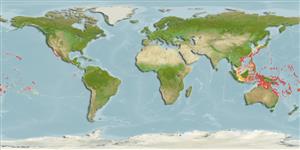分類 / Names
俗名 | 同種異名 | Catalog of Fishes(屬, 種) | ITIS | CoL | WoRMS | Cloffa
Teleostei >
Eupercaria/misc (Various families in series Eupercaria)
鱸形目 (Various families in series Eupercaria) >
Labridae (Wrasses)
隆頭魚科 (Wrasses) > Corinae
Etymology: Pseudojuloides: Greek, pseudes = false + Greek, iouis = a fish without identification, perhaps some of genus Coris cited by Plinius + Greek, oides = similar to (Ref. 45335).
More on authors: Randall & Randall.
Environment: milieu / climate zone / depth range / distribution range
生態學
海洋 礁區魚類; 深度上下限 25 - 45 m (Ref. 90102), usually 32 - 39 m (Ref. 2140). 熱帶
Western Pacific: Philippines, Indonesia and Papua New Guinea. Recently recorded from Tonga (Ref. 53797).
西太平洋: 菲律賓,印尼與巴布亞新幾內亞。 最近從東加記錄。 (參考文獻 53797)
大小 / 重量 / 年齡
Maturity: Lm ? range ? - ? cm
Max length : 7.0 cm SL 雄魚/尚未辨別雌雄; (Ref. 2140)
背棘 (總數): 9; 背的軟條 (總數): 11; 臀棘 3; 臀鰭軟條: 12; 脊椎骨: 15. Male body orangish brown dorsally, whitish ventrally; spots on body may diffuse to form a midlateral band; large black spot in middle of body continuous with the large black area of the dorsal fin. 10-11 median predorsal rays; 6-8 suborbital pores; 8-11 pores on free margin of preopercle; 3 pores anterior to orbit. Females pink like other species of the genus (Ref. 48636).
雄性身體橘褐色的背面, 微白色的腹地; 在身體上的斑點可能擴散的形成一個側面中央的條紋; 在身體的中央的大的黑色斑點與背鰭的大的黑色區域續接在一起。 10-11 中央的前背鰭條; 6-8個眶下的孔; 在前鰓蓋骨的分離邊緣上的 8-11個孔; 3個孔位於眼窩前。 雌性粉紅色類似其他種的本屬。 (參考文獻 48636)
Lives in very deep water, usually in depth 30-40 m or more (Ref. 48636). Occurs solitary or in pairs (Ref. 90102) in open rubble bottoms with small corals (Ref. 2140).
生活在很深的水域, 通常在深度 30-40 公尺或更多.(參考文獻 48636) 出現於開放的碎石底部有小的珊瑚。
Life cycle and mating behavior
成熟度 | 繁殖 | 產卵場 | 卵 | 孕卵數 | 仔魚
Oviparous, distinct pairing during breeding (Ref. 205).西太平洋: 菲律賓,印尼與巴布亞新幾內亞。 最近從東加記錄。 (參考文獻 53797)
Randall, J.E. and H.A. Randall, 1981. A revision of the labrid fish genus Pseudojuloides, with descriptions of five new species. Pac. Sci. 35(1):51-74. (Ref. 2140)
人類使用
更多資訊
參考文獻養殖養殖資訊品種遺傳學Electrophoreses遺傳率疾病加工NutrientsMass conversion
合作者照片Stamps, Coins Misc.聲音神經毒速度泳型鰓區Otoliths腦重體重比眼睛色素
工具
特別的報告
下載 XML
網路資源
Estimates based on models
Preferred temperature (Ref.
123201): 23.8 - 27.9, mean 26.5 °C (based on 31 cells).
Phylogenetic diversity index (Ref.
82804): PD
50 = 0.5000 [Uniqueness, from 0.5 = low to 2.0 = high].
Bayesian length-weight: a=0.00977 (0.00470 - 0.02030), b=3.07 (2.89 - 3.25), in cm total length, based on LWR estimates for this (Sub)family-body shape (Ref.
93245).
營養階層 (Ref.
69278): 3.3 ±0.4 se; based on size and trophs of closest relatives
回復力 (Ref.
120179): 高度, 族群倍增時間少於 15個月 (Preliminary K or Fecundity.).
Fishing Vulnerability (Ref.
59153): Low vulnerability (10 of 100).
